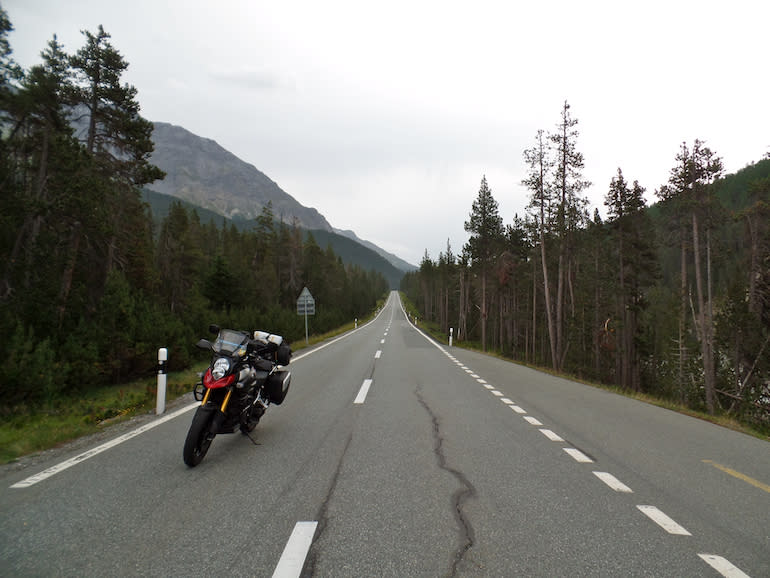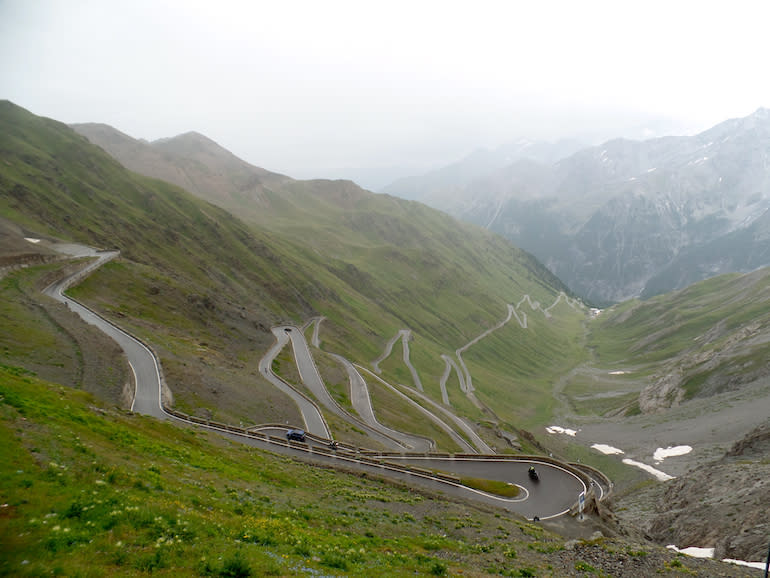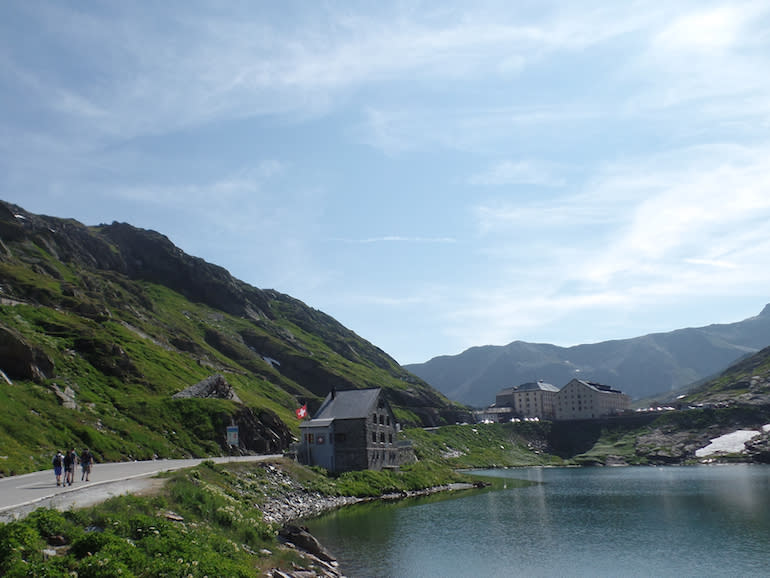How To: Riding in the Alps
I had the incredible good fortune recently to undertake an epic European ride, which included stints in the Swiss, Italian, German and French sections of the Alps. I rode a number of famous mountain passes, including San Bernadino Pass, Great St. Bernard Pass, Albula Pass, Umbrail Pass and the famous Stelvio Pass (from whence the Moto Guzzi Stelvio gets its name)
MUST READ: Elena Myers- American Road Racing’s Leading Lady | RideApart
The trip was, quite simply, the coolest thing I've done in my riding career (so far). The picture above is one I may have framed so I can stare at it when I'm frustrated and remind myself that life is sometimes really, really awesome.
I know it's not easy and it's definitely not cheap, but riding in the Alps should be on your bucket list. To help make it happen, I've put together the following "How-To" guide:

Splugensee, Switzerland
Get your head right
Before you set foot or tire in the Alps, work on getting yourself mentally prepared for being there— especially as it pertains to interactions off the bike. The Alps draw riders from everywhere, who play a big part in making the experience so memorable.
British and Dutch riders are the friendliest, Swiss and Austrian riders are (perhaps unsurprisingly) the most skilled, and Italian riders are the least sane. But you'll have a good time interacting with them all, as well as folk from dozens of other countries. Being on a motorcycle is open invitation to anyone to start a conversation.
MUST READ: Wayne Rainey’s Crazy Cool Wheelchair Grom-Looking Trike | RideApart
Ever larger numbers of people speak English in Europe—especially younger people and those in cosmopolitan areas. In Switzerland, you'll occasionally find English on road signs, but it's basic courtesy to learn greetings and pleasantries for countries you'll be riding through. Work on developing the ability to speak English slowly and clearly without sounding condescending. And to that last point, never ever, ever be critical of another person's country. Ever. There's no point and it will not help you in any way.
This is doubly true regarding your attitude toward the place you are in. You're a bloody foreigner, son, and any opinion or attitude other than "this place is the best" will hamper your ability to have a good time. If there's stuff you don't like, keep it to yourself until you get home, or until you're amongst Germans, who have elevated criticism of other countries to an art form.

Swiss National Park
What to ride
The best bike to ride in the Alps, of course, is the bike with which you are most familiar and comfortable. In my case, that was my own Suzuki V-Strom 1000. But I live in Britain. The bulk of RideApart's readership is in North America, so I'll assume you and your machine are an ocean away from the European Union.
I've heard of some folks shipping bikes across said ocean, but I can't imagine this being a terribly great option except in cases where you're planning to spend several months here. Even then, it might turn out to be cheaper and easier to just turn up and buy a used bike. Choose a Japanese model or BMW since dealerships for these are abound throughout Europe. Avoid Triumphs except in Britain; I've heard horror stories of people being waylaid for several weeks waiting for parts.
CLICK TO CONTINUE READING
More likely, though, you'll want to rent. There are a number of companies offering different makes and models for hire. Google is your friend in finding them, and there are dozens to choose from. I'd personally avoid renting a Harley-Davidson or the like. Not because I'm a Harley hater (in fact, I think they're really cool), but because they aren't the right tool for the job, unless you possess an extraordinarily high level of skill in maneuvering big bikes in small spaces. Alpine passes are very twisty—very, very twisty. On the infamous Stevio Pass, I was touching down the hero blobs on my V-Strom.
MUST READ: Mistakes New Riders Make in the First Six Months | RideApart

Stelvio Pass. It gets even more challenging below the tree line.
Don't be afraid to go small either. There's no incredible speed to be had on the passes, and being able to muscle your bike will add confidence.
Obviously, the easiest route is to go with a tour operator like Edelweiss or Motorrad Tours, who will not only provide bikes, but also provide knowledgeable guides and itineraries that take the stress out of figuring out where to eat, sleep and ride. The drawbacks to this, of course, are that tour operators are not cheap. You can't change their itinerary, and you'll inevitably find yourself spending a week in the company of a Connecticut day trader who is going through his midlife crisis.
How to ride
Although I'm an American citizen, I live in Wales, which is home to some of the best riding in the UK and several challenging roads. I hold my own here, but I'm not ashamed to admit that the Alpine passes kicked my butt. It's important to accept that the mountains are better than you and ride accordingly, rather than trying to match anyone else's perceived skill level or the vision you might have had for yourself.

Village marking border between Italy and Switzerland at Umbrail Pass
It can be humbling to be schooled by some French dude on a maxi-scooter, but the key to having a good time and avoiding any first-hand experience with European health care is riding within your own abilities. Keep in mind, too, those abilities will be diminished due to unfamiliarity with the terrain and the natural tiredness that comes with travel.

 Yahoo Autos
Yahoo Autos 
